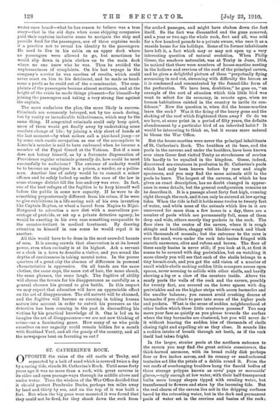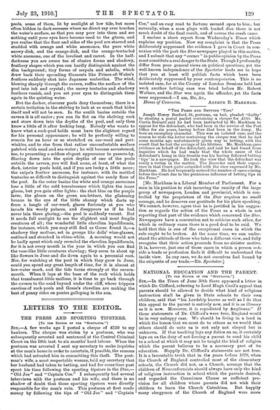ST. CATHERINE'S ROCS.
OPPOSITE the rains of the old castle at Tenby, and separated by a belt of sand which is covered twice a day by a racing tide, stands St. Catherine's Rock. Until some forty years ago it was no more than a rock, with great caverns in its sides and open passage-ways through its middle above and under water. Then the wisdom of the War Office decided that it should protect Pembroke Docks, perhaps ten miles away by land and thirty by sea, and on the top of it was built a fort. But when the big guns were mounted it was found that they could not be fired, for they shook down the rock from
the arched passages, and might have shaken down the fort itself. So the fort was dismantled and the guns removed,
and a year or two ago the whole rock, fort and all, was sold for a few hundred pounds to a private owner, who uses it as a seaside house for his holidays. Some of its former inhabitants have left it, a fact which may or may not open up a very interesting question of natural evolution. When Philip Gosse, the seashore naturalist, was at Tenby in June, 1854, he noticed that there were numbers of house-martins nesting in the hollows and crevices of the roof of the principal cavern, and he gives a delightful picture of them "perpetually flying screaming in and out, stemming with difficulty the breeze as it is condensed and concentrated by the funnel-like form of the perforation. We have here, doubtless," he goes on, " an example of the sort of situation which this little bird was wont to select for its economy, in remote ages, when no human habitations existed in the country to invite its con.. fidence." Now the question is, when did the house-martins leave the rock P Was it the firing of the heavy guns and the shaking of the roof which frightened them away ? Or do we see here, at some point in a period of fifty years, the definite abandonment by a particular bird of an inherited habit P It would be interesting to think so, but it seems more natural to blame the War Office.
But the house-martins were never the principal inhabitants of St. Catherine's Rock. The boulders at its base, and the pools in the caverns and under the boulders, have been known ever since Gosse first visited Tenby as storehouses of marine life hardly to be equalled in the kingdom. Gosse, indeed, discovered sea-creatures in profusion in St. Catherine's pools which bad only been known before by rare and single specimens, and you may find the same animals still in the pools be knew. The largest of the caverns, of which he has given an exact description, has no doubt changed in appear- ance in some details, but the general configuration remains as he describes it. It is a passage about forty feet high, running right through the rock, and it can only be entered at low spring tides. When the tide is full it holds some twelve to twenty feet of water, and while none of the animals which live in it are uncovered for more than a few hours in a day, there are a number of pools which are permanently full, some of them deep and wide, others merely tiny pockets in the rock. The floor rises in the centre of the cavern, where it is rough shingle and boulders, shaggy with bladder-wrack and black with thousands of mussels; but the entrance to the cave is over flat sand, worn under the rock into basins fringed with smooth anemones, olive and rufous and brown. The floor of these sandy basins is never still; if you look at it, at first it seems to be covered with dog periwinkles, but on watching it more closely you will see that each of the shells belongs to a tiny hermit-crab, and you get the odd vision of a number of small winkle-shells making sudden little scampers across open spaces, never seeming to collide with other shells, and hardly showing a leg or a claw of the creature inside. Above the sandy pools the walls of the rock and the cavern, possibly for twenty feet, are covered on the lower spaces with dog periwinkles and on the higher strips with acorn barnacles and the smaller balanus ; you cannot avoid crushing dozens of barnacles if you climb to peer into some of the higher pools and pockets. What is the sense of sudden neighbourhood of other bodies which these little creatures possess ? You may move your face as quietly as you please towards the surface where the tiny barnacles are clustered, but you will never do • it without hearing the sudden hiss of thousands of shells closing tight and expelling air as they close. It sounds like a sudden intake of breath through Bet teeth, as if the rock itself had taken fright.
In the larger, stonier pools at the northern entrance to the cavern you may find the great aetinia erassieornis, the thick-horned anemone, with its broad ruddy disk perhaps four or five inches across, and its creamy or sand-coloured tentacles set like the petals of a dahlia round it. From the wet roofs of overhanging boulders hang the flaccid bodies of those strange polypes known as cows' paps or mermaids' gloves,—ugly enough at low water, with their half-transparent bulbs mere lumpy shapes tipped with exuding water, but transformed to flowers and stars by the incoming tide. But the real charm of the cavern lies not in the dripping surfaces bared by the retreating water, but in the dark and permanent pools of water set in the crevices and basins of the rock;
pools, some of them, lit by sunlight at low tide, but more often hidden in dark recesses where no direct ray ever touches the water's surface, so that you may peer into them and see nothing until your eyes have become used to the gloom, and you realise that the floor and sides of the pool are starred and studded with orange and white anemones, the pure white snowy-disk, and the orange-disk, and the orange-tentacled white anemone, one of the loveliest and rarest. In the half- darkness you are aware too of elusive forms and shadowy, feathery shapes which you can hardly distinguish against the dim background ; tiny forms of serpula and sabella, which draw back their spreading filaments like Prince-of-Wales's feathers suddenly shut into Japanese umbrellas. The wind, blowing sharply through the cavern, ruffles the surface of the pool into ink and crystal ; the snowy tentacles and shadowy feathers vanish, and you set your eyes to distinguish them again in the quieting water.
But the darker, obscurer pools deny themselves; there is a certain irritation in the striving to look at so much that hides itself and will not be seen. In the sunlit basins outside the cavern it is all easier ; you can lie fiat on the shelving rock and stare down into the depths of the pool, and only then know a little of it after looking long. Nobody who wants to know what a rock-pool holds must have the slightest regard for his personal appearance ; he will be perfectly willing to remain for an hour or so stretched on oar-weed and peri- winkles, and to rise from that rather uncomfortable surface patched with sand and sea-water ; he will become accustomed, too, to presenting a seldom elegant appearance to passers-by. Staring down into the quiet depths of one of the pools outside the cavern, you will find some, at least, of what the dark, interior pools hold, and if you are lucky a little more ; the snipe's feather anemone, for instance, with its mottled tentacles so difficult to distinguish against the sandy floor of the pool. In the outer basins the white and orange anemones lose a little of the cold translucence which lights the inner gloom, but you gain other lights : the shot blue on the purple laver, the gleam on the green sea-lettuce, the glistening bronze in the eye of the little shanny which darts up from a tangle of oar-weed, glares furiously at you who invade his weedy palaces, and disappears as if he had never lain there glaring,—the pool is suddenly vacant. But it needs full sunlight to see the slightest and most fragile creatures of all ; the wonderful little clavelina lepadiformis, for instance, which you may still find as Gosse found it,—a shadowy tiny mollusc, set in groups like dolls' wine-glasses, outlined and streaked in china-white. A morning would not be badly spent which only revealed the clavelina lepadiformis, for it is not every month in the year in which you can find the vase-like little creatures showing; they seem to shoot up like flowers in June and die down again to a perennial root. Nor, for watching at the pool in which they grow in June, could you spend any great length of time, for it is almost at low-water mark, and the tide turns strongly at the cavern- mouth. When it laps at the base of the rock which holds that translucent little mollusc, it is time to go back through the cavern to the sand beyond under the cliff, where trippers careless of rock-pools and Gosse's clavelina, are making the best of penny rides on ponies galloping in the sun.







































 Previous page
Previous page